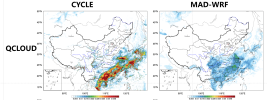Hi, I'm trying to run MAD-WRF and success. But I have some questions about it.
1. I have add CLDMASK, CLDBASEZ, CLDTOPZ, and BRTEMP to the METGRID.TBL to generate intermediate files and met_em.d01*, and real.exe to generate wrfinput_d01.*. However, all of the above is based on a cold run driving by EC and everything looks good. However, the initialized water condensate content is very low (Figure 1 right)compared with normal WRF(Figure 1 left), which is due to that the cold run does not contain water condensate.
2. So, the best is to use the results from the previous forecast time (T-1). But how to do cloud initialization from wrfout? Does real.exe still work?
3. Cloud initialization exists in the same way as in CLD3, with the ‘adjust_cloudH2O’、‘adjust_cloudIce’ and 'adjust_cloudFinal' (Figure 2). There are some increments added to this, which is why cold run can still get water condensation. But how is this qlcloud handled if there are no clouds shown in the wrfout but there are clouds in the observation (first qi = 0 or qc =0 on the right side of the equation, Figure 2)?
The increment in CLD3 is understandable, I think it's the low water condensate content in the model, and this also came up in my research. But is it necessary to set this in the initial cloud of mad-wrf as well? This may result in a double increase when CLD3 is selected in the integration.
4. I think the best way would be to get the 3D water condensate distribution directly from the satellite, but this is very difficult, what do you suggest?

Figure 1 QCLOUD


Figure 2 code of mad-wrf in 'adjust_cloudH2O' and 'adjust_cloudIce'
1. I have add CLDMASK, CLDBASEZ, CLDTOPZ, and BRTEMP to the METGRID.TBL to generate intermediate files and met_em.d01*, and real.exe to generate wrfinput_d01.*. However, all of the above is based on a cold run driving by EC and everything looks good. However, the initialized water condensate content is very low (Figure 1 right)compared with normal WRF(Figure 1 left), which is due to that the cold run does not contain water condensate.
2. So, the best is to use the results from the previous forecast time (T-1). But how to do cloud initialization from wrfout? Does real.exe still work?
3. Cloud initialization exists in the same way as in CLD3, with the ‘adjust_cloudH2O’、‘adjust_cloudIce’ and 'adjust_cloudFinal' (Figure 2). There are some increments added to this, which is why cold run can still get water condensation. But how is this qlcloud handled if there are no clouds shown in the wrfout but there are clouds in the observation (first qi = 0 or qc =0 on the right side of the equation, Figure 2)?
The increment in CLD3 is understandable, I think it's the low water condensate content in the model, and this also came up in my research. But is it necessary to set this in the initial cloud of mad-wrf as well? This may result in a double increase when CLD3 is selected in the integration.
4. I think the best way would be to get the 3D water condensate distribution directly from the satellite, but this is very difficult, what do you suggest?

Figure 1 QCLOUD


Figure 2 code of mad-wrf in 'adjust_cloudH2O' and 'adjust_cloudIce'
